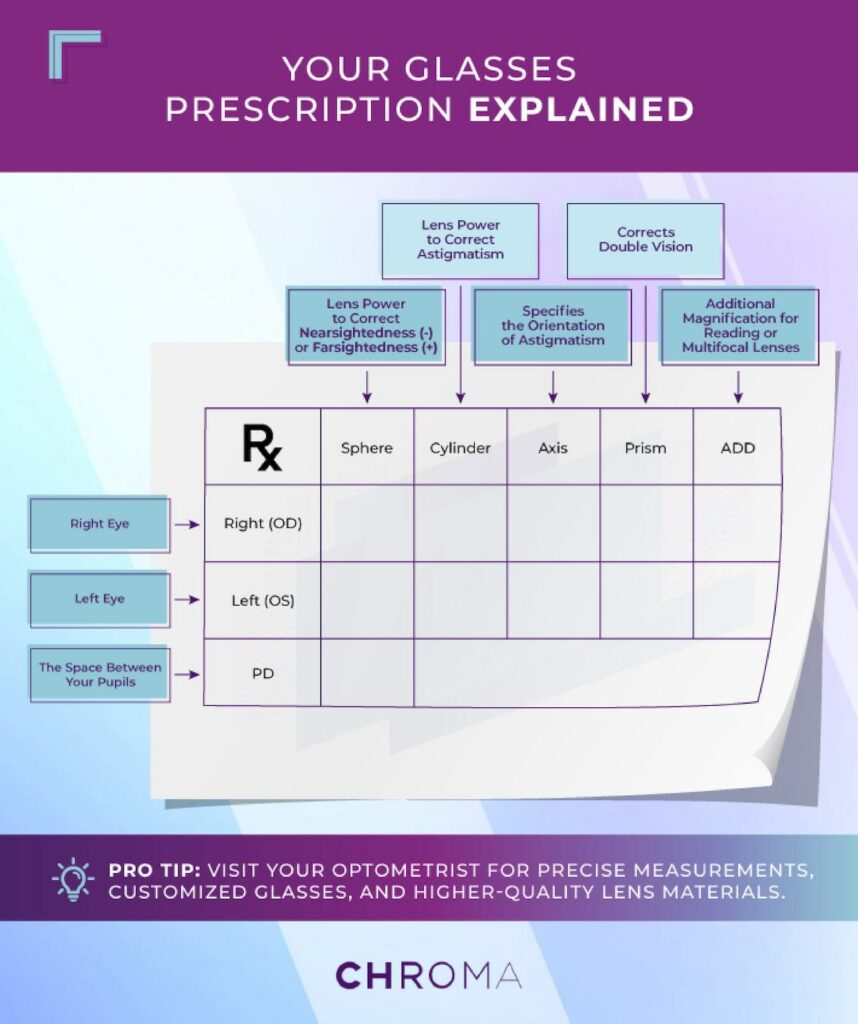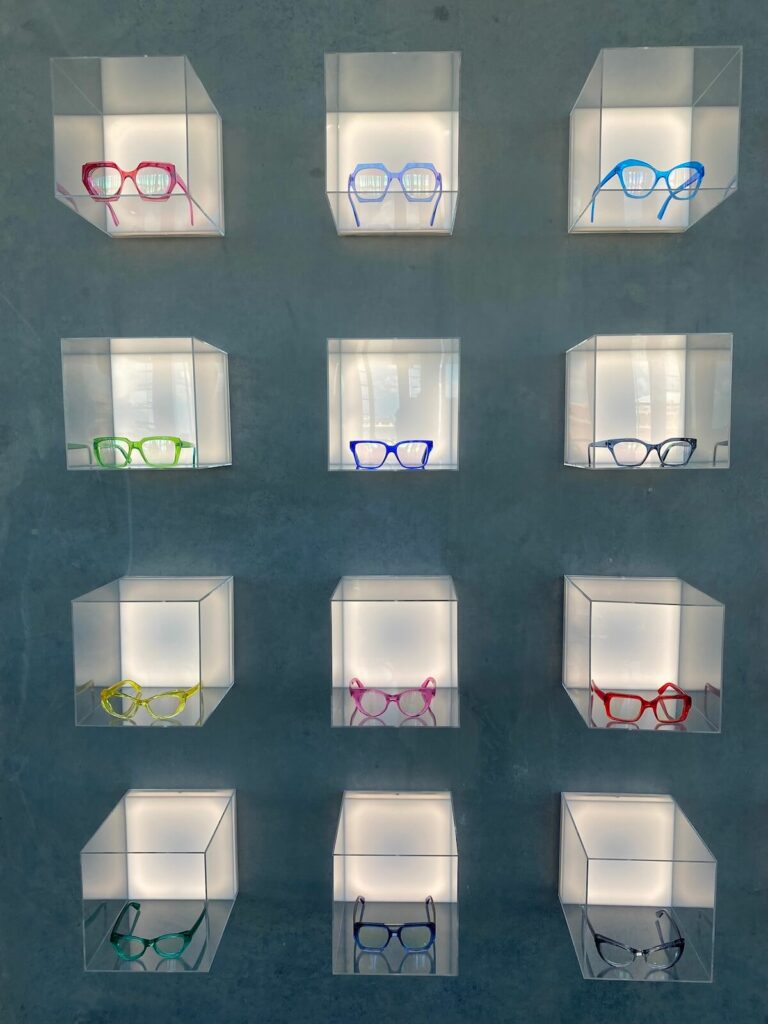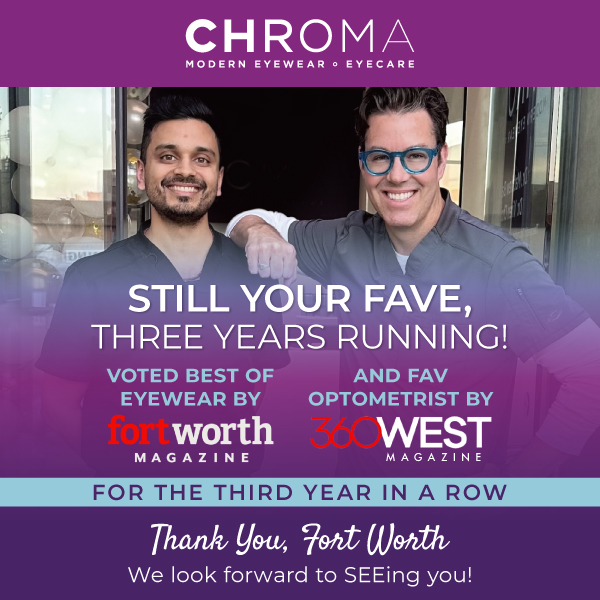Do you look at your glasses prescription and feel it’s written in code? You’re not alone. The mix of numbers and abbreviations can be confusing.
A glasses prescription includes values like SPH (sphere) for nearsightedness or farsightedness, CYL (cylinder) for astigmatism, and axis to indicate the correction’s orientation. It may also have an ADD power for reading or multifocal lenses.
Opticians and optometrists are trained to interpret these details and craft glasses that provide clear, comfortable vision. That means higher-quality lenses, precise customization, and a precise fit—something online retailers simply can’t match.
What the Numbers & Abbreviations Mean
Your glasses prescription specifies your vision needs. Here’s how to understand it:
- OD vs. OS: OD stands for “oculus dexter” (the right eye), and OS stands for “oculus sinister” (the left eye). You might also see “OU” (oculus uterque) for both eyes.
- SPH (sphere): This value measures the degree of refractive error and indicates if you’re nearsighted or farsighted.
- CYL (cylinder) and axis: If you have astigmatism, these values matter. CYL measures the degree of astigmatism, while the axis (0°–180°) pinpoints its orientation.
- ADD or NV-ADD (add power): This number is important for bifocal or progressive lenses and shows additional correction needed for close-up tasks like reading.
Understanding Sphere, Cylinder, & Axis
Don’t worry if SPH, CYL, and axis still don’t make total sense—we’ll break them down in more detail.
SPH
The SPH number indicates the lens power needed to correct nearsightedness or farsightedness, measured in diopters (D)—the unit of measurement for optical power.
- A minus (-) value means you’re nearsighted (myopia) and see better up close. The higher the number, the stronger the correction.
- A plus (+) value means you’re farsighted (hyperopia) and see better at a distance. Higher numbers indicate a greater need for correction.
For example, a prescription of -2.50 D means moderate nearsightedness, while +1.00 D indicates mild farsightedness.
CYL
The CYL number corrects astigmatism. This refractive error occurs when the eye’s shape isn’t perfectly round, which causes blurred or distorted vision.
- The higher the CYL value, the more correction is needed to adjust for the irregular curvature.
- If no CYL value is listed, no astigmatism correction is required.
CYL always works in combination with the axis value to fine-tune how light focuses on the retina for clearer vision.
Axis
The axis number works alongside CYL to correct astigmatism. It specifies the angle (between 1° and 180°) where the correction is applied.
It’s the direction in which your lenses need to focus light for the clearest vision. Without the correct axis, objects may appear blurry or distorted, even with astigmatism correction.
PD
PD measures the distance in millimeters between your pupils, ensuring your lenses align correctly with your eyes for optimal focus and visual clarity.
This measurement is essential for properly centering your prescription lenses—especially for multifocal or progressive lenses—so you experience comfortable, accurate vision correction.

Reading Bifocal & Progressive Lens Prescriptions
If you’re transitioning to bifocals or progressives, there’s a bit more to understand. These lenses require additional measurements to ensure seamless vision at all distances—whether up close, at arm’s length, or far away. Here’s what to look for in your prescription:
Bifocal Prescriptions
Bifocals feature distinct zones for both distance and near vision correction. The ADD (near vision addition) number specifies how much magnification is needed for close-up tasks like reading.
This additional power is crucial for ensuring you can focus clearly on nearby objects while still having clear distance vision through the upper part of the lens.
Progressive Lenses
Progressive lenses gradually transition between distance, intermediate, and near vision. Your prescription may include an ADD power for progressives, tailored to your specific vision needs.
Unlike bifocals, progressives provide a smooth, continuous field of vision without a visible line, providing natural sight at all distances.
Why Getting a Professional Fitting Matters
Finding the right pair of glasses is about more than choosing frames that look good—it’s a careful process supported by advanced technology.
At CHROMA modern Eyewear Eyecare, a professional fitting means your glasses will not only be stylish but also comfortable and functional. We invest in advanced fitting technology that allows you to try on frames before making a purchase, giving you the chance to see how they look and receive feedback on fit and style.
A professional fitting also provides additional benefits, like:
- Custom lens precision: Progressive lenses are fitted in real-time with our smart mirror system, ensuring better placement for natural vision without the need for multiple tests.
- Advanced prescription technology: The i.Profiler plus by ZEISS with i.Scription technology delivers ultra-precise prescriptions, measuring up to 1/100 of a diopter for sharper colors, better contrast, and improved night vision.
- Added protection: All lenses come with built-in UV protection and scratch resistance for lasting durability and clearer vision.
Get Eyewear That’s Made for You
By now, you likely have a good understanding of how to read your glasses prescription—now it’s time to find a fresh pair of glasses.
While online retailers may offer convenience, they often lack the precision and quality control necessary for optimal vision correction. The fit and quality of glasses depend on more than just the prescription numbers. Accurate measurements, high-quality lenses, and personalized adjustments all play important roles in your vision quality.
Choosing a provider that prioritizes precision and craftsmanship means your glasses will not only correct your vision accurately but also feel comfortable and perform better in the long term. Visit CHROMA modern Eyewear Eyecare to find your next pair.



